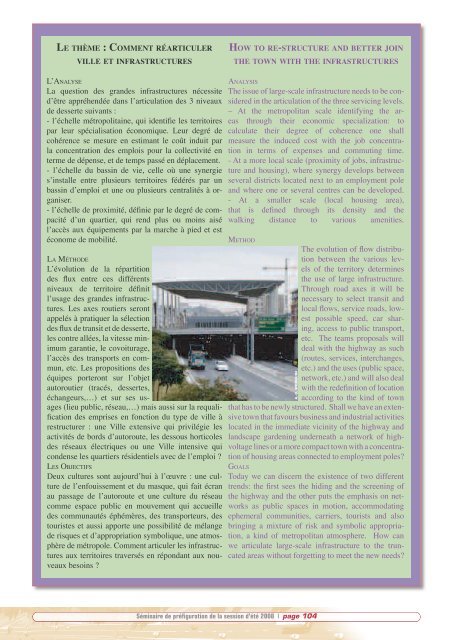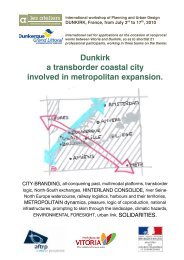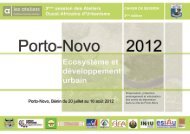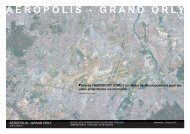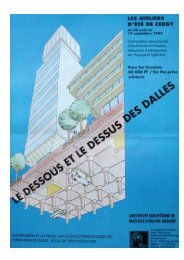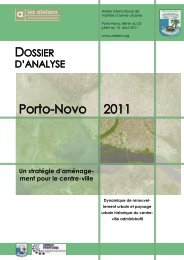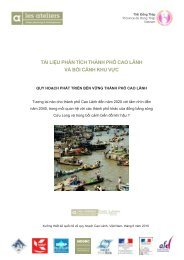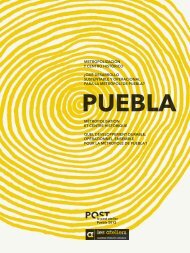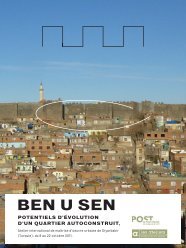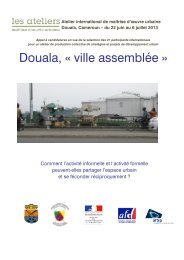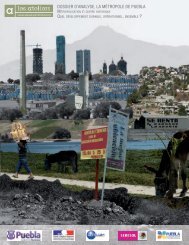actes colloque 2007 - Les Ateliers
actes colloque 2007 - Les Ateliers
actes colloque 2007 - Les Ateliers
You also want an ePaper? Increase the reach of your titles
YUMPU automatically turns print PDFs into web optimized ePapers that Google loves.
LE THÈME : COMMENT RÉARTICULER<br />
VILLE ET INFRASTRUCTURES<br />
HOW TORE-STRUCTURE AND BETTER JOIN<br />
THE TOWN WITH THE INFRASTRUCTURES<br />
L<br />
L’ANALYSE<br />
La question des grandes infrastructures nécessite<br />
d’être appréhendée dans l’articulation des 3 niveaux<br />
de desserte suivants :<br />
- l’échelle métropolitaine, qui identifie les territoires<br />
par leur spécialisation économique. Leur degré de<br />
cohérence se mesure en estimant le coût induit par<br />
la concentration des emplois pour la collectivité en<br />
terme de dépense, et de temps passé en déplacement.<br />
- l’échelle du bassin de vie, celle où une synergie<br />
s’installe entre plusieurs territoires fédérés par un<br />
bassin d’emploi et une ou plusieurs centralités à organiser.<br />
- l’échelle de proximité, définie par le degré de compacité<br />
d’un quartier, qui rend plus ou moins aisé<br />
l’accès aux équipements par la marche à pied et est<br />
économe de mobilité.<br />
LA MÉTHODE<br />
L’évolution de la répartition<br />
des flux entre ces différents<br />
niveaux de territoire définit<br />
l’usage des grandes infrastructures.<br />
<strong>Les</strong> axes routiers seront<br />
appelés à pratiquer la sélection<br />
des flux de transit et de desserte,<br />
les contre allées, la vitesse minimum<br />
garantie, le covoiturage,<br />
l’accès des transports en commun,<br />
etc. <strong>Les</strong> propositions des<br />
équipes porteront sur l’objet<br />
autoroutier (tracés, dessertes,<br />
échangeurs,…) et sur ses usages<br />
(lieu public, réseau,…) mais aussi sur la requalification<br />
des emprises en fonction du type de ville à<br />
restructurer : une Ville extensive qui privilégie les<br />
activités de bords d’autoroute, les dessous horticoles<br />
des réseaux électriques ou une Ville intensive qui<br />
condense les quartiers résidentiels avec de l’emploi <br />
LES OBJECTIFS<br />
Deux cultures sont aujourd’hui à l’œuvre : une culture<br />
de l’enfouissement et du masque, qui fait écran<br />
au passage de l’autoroute et une culture du réseau<br />
comme espace public en mouvement qui accueille<br />
des communautés éphémères, des transporteurs, des<br />
touristes et aussi apporte une possibilité de mélange<br />
de risques et d’appropriation symbolique, une atmosphère<br />
de métropole. Comment articuler les infrastructures<br />
aux territoires traversés en répondant aux nouveaux<br />
besoins <br />
ANALYSIS<br />
The issue of large-scale infrastructure needs to be considered<br />
in the articulation of the three servicing levels.<br />
– At the metropolitan scale identifying the areas<br />
through their economic specialization: to<br />
calculate their degree of coherence one shall<br />
measure the induced cost with the job concentration<br />
in terms of expenses and commuting time.<br />
- At a more local scale (proximity of jobs, infrastructure<br />
and housing), where synergy develops between<br />
several districts located next to an employment pole<br />
and where one or several centres can be developed.<br />
- At a smaller scale (local housing area),<br />
that is defined through its density and the<br />
walking distance to various amenities.<br />
METHOD<br />
WERQUIN<br />
according to the kind of town<br />
that has to be newly structured. Shall we have an extensive<br />
town that favours business and industrial activities<br />
located in the immediate vicinity of the highway and<br />
landscape gardening underneath a network of highvoltage<br />
lines or a more compact town with a concentration<br />
of housing areas connected to employment poles<br />
A.-C.<br />
The evolution of flow distribution<br />
between the various levels<br />
of the territory determines<br />
the use of large infrastructure.<br />
Through road axes it will be<br />
necessary to select transit and<br />
local flows, service roads, lowest<br />
possible speed, car sharing,<br />
access to public transport,<br />
etc. The teams proposals will<br />
deal with the highway as such<br />
(routes, services, interchanges,<br />
etc.) and the uses (public space,<br />
network, etc.) and will also deal<br />
with the redefinition of location<br />
GOALS<br />
Today we can discern the existence of two different<br />
trends: the first sees the hiding and the screening of<br />
the highway and the other puts the emphasis on networks<br />
as public spaces in motion, accommodating<br />
ephemeral communities, carriers, tourists and also<br />
bringing a mixture of risk and symbolic appropriation,<br />
a kind of metropolitan atmosphere. How can<br />
we articulate large-scale infrastructure to the truncated<br />
areas without forgetting to meet the new needs<br />
UN<br />
Situ<br />
préf<br />
un p<br />
Ile-d<br />
Sa s<br />
de 2<br />
bou<br />
du V<br />
cité<br />
La<br />
Pon<br />
de<br />
mul<br />
com<br />
viro<br />
don<br />
ans.<br />
Gra<br />
lent<br />
ants<br />
90.0<br />
3.80<br />
son<br />
l’ag<br />
tiell<br />
Mo<br />
mai<br />
soci<br />
Cer<br />
tion<br />
cité<br />
et d<br />
La<br />
d’A<br />
poli<br />
bain<br />
la c<br />
d’am<br />
tran<br />
d’éd<br />
Cer<br />
néce<br />
rovi<br />
perm<br />
ture<br />
ise à<br />
La D<br />
(ou<br />
inte<br />
Séminaire de préfiguration de la session d’été 2008 | page 104<br />
POUR S’INSCRIRE... / HOW TO REGISTER...<br />
QUI<br />
Peuve<br />
des ét<br />
des ra<br />
partic<br />
Cergy


